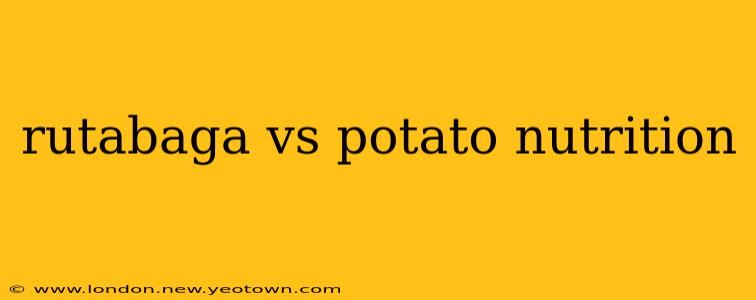For centuries, potatoes and rutabagas have served as humble staples in kitchens worldwide. But when it comes to nutrition, which of these root vegetables reigns supreme? This isn't a simple "winner takes all" contest; instead, we'll explore the nutritional profiles of both to help you make informed choices about what to include in your diet. Our journey begins with a taste of history, a dash of culinary tradition, and a deep dive into the vitamins, minerals, and other beneficial compounds found within each root.
Imagine a crisp autumn day. You're strolling through a farmer's market, the air filled with the earthy scent of freshly harvested produce. Before you lie mountains of russet potatoes, their skins a deep mahogany, and alongside them, the paler, subtly sweeter rutabagas, their flesh a creamy yellow. Both beckon, promising warmth and sustenance. But which one offers the better nutritional bang for your buck?
Rutabaga Nutrition: The Unsung Hero
Often overshadowed by its more popular cousin, the potato, the rutabaga quietly packs a nutritional punch. This hybrid vegetable, a cross between a turnip and a cabbage, is a treasure trove of vitamins and minerals.
What are the benefits of eating rutabagas?
Rutabagas are low in calories but high in fiber, making them excellent for digestive health. Their high vitamin C content contributes to a strong immune system, and they're also a good source of potassium, vital for maintaining healthy blood pressure. Furthermore, they contain antioxidants, which combat damaging free radicals in the body, potentially reducing the risk of chronic diseases. They’re a delicious and versatile addition to any healthy diet.
Potato Nutrition: The Familiar Favorite
The potato, a global culinary icon, is far from a nutritional lightweight. Though often unfairly maligned for its carbohydrate content, it offers several benefits when consumed thoughtfully.
Are potatoes healthy?
Yes, potatoes can be a healthy part of a balanced diet. They're a significant source of potassium, similar to rutabagas. They also provide vitamin C and some B vitamins. The nutritional content, however, varies significantly depending on how the potato is prepared. Baked or boiled potatoes retain more of their nutrients than those that are fried. The skin also contains a high concentration of nutrients, so leaving it on is beneficial.
Rutabaga vs. Potato: A Detailed Comparison
Let’s delve deeper into a head-to-head comparison of these two root vegetables:
| Nutrient | Rutabaga (1 cup, cooked) | Potato (1 medium, baked, with skin) |
|---|---|---|
| Calories | ~50 | ~160 |
| Fiber | ~4g | ~4g |
| Vitamin C | ~20% DV | ~20% DV |
| Potassium | ~10% DV | ~12% DV |
| Vitamin B6 | ~5% DV | ~10% DV |
| Magnesium | ~5% DV | ~10% DV |
(DV = Daily Value. Note that DV percentages can vary slightly depending on the source and specific preparation method.)
As you can see, both rutabagas and potatoes offer comparable levels of certain key vitamins and minerals. The most notable difference lies in the calorie count; potatoes are significantly higher in calories, primarily due to their higher carbohydrate content.
What are the differences between a rutabaga and a potato?
The primary differences lie in their taste, texture, and calorie count. Rutabagas have a slightly sweet and peppery flavor, while potatoes offer a more neutral taste, which can be easily enhanced with various seasonings and cooking methods. Rutabagas tend to be firmer than potatoes. Their distinct flavors and textures lead to diverse culinary uses.
Which is healthier: rutabaga or potato?
There's no single "healthier" option. Both offer valuable nutrients. The best choice depends on your individual dietary needs and preferences. If you're watching your calorie intake, rutabagas are a lower-calorie option. However, potatoes' higher carbohydrate content might be beneficial for those requiring more energy. The way they're prepared also makes a difference.
Conclusion: A Place for Both
Both rutabagas and potatoes deserve a place in a healthy and balanced diet. Their distinct nutritional profiles and culinary versatility allow for diverse meal planning. By understanding their respective strengths, you can make conscious choices that support your overall well-being. So next time you’re at the farmer's market, don't hesitate to grab both!

